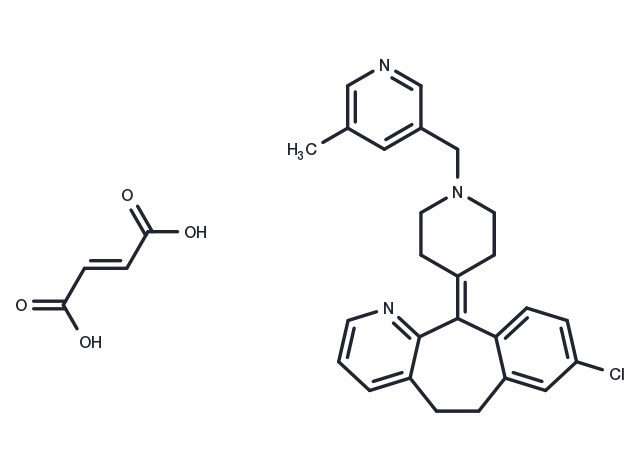Powder: -20°C for 3 years | In solvent: -80°C for 1 year


Rupatadine Fumarate (Rinialer) (UR-12592 Fumarate) is a potent dual PAF/H1 antagonist with Ki of 0.55/0.1 uM.

| Pack Size | Availability | Price/USD | Quantity |
|---|---|---|---|
| 50 mg | In stock | $ 54.00 | |
| 100 mg | In stock | $ 78.00 | |
| 500 mg | In stock | $ 158.00 | |
| 1 mL * 10 mM (in DMSO) | In stock | $ 50.00 |


| Description | Rupatadine Fumarate (Rinialer) (UR-12592 Fumarate) is a potent dual PAF/H1 antagonist with Ki of 0.55/0.1 uM. |
| Targets&IC50 | PAFR:550 nM(Ki), H1 receptor:102 nM(Ki) |
| In vitro | Rupatadine inhibits both platelet-activating factor (PAF) and histamine (H1) effects through its interaction with specific receptors. Rupatadine competitively inhibits histamine-induced guinea pig ileum contraction (pA2 = 9.29 ± 0.06) without affecting contraction induced by ACh, serotonin or leukotriene D4(LTD4). It also competitively inhibits PAF-induced platelet aggregation in washed rabbit platelets (WRP) (pA2= 6.68 ± 0.08) and in human platelet-rich plasma (HPRP) (IC50 = 0.68 μM), while not affecting ADP- or arachidonic acid-induced platelet aggregation. [1] In another study, it is reported rupatadine and loratadine shows similar inhibitory effect on histamine and TNF-α release, whereas SR-27417A only exhibits inhibitory effect against TNF-α. [2] |
| In vivo | Rupatadine blocks histamine- and PAF-induced effects in vivo, such as hypotension in rats (ID50 = 1.4 and 0.44 mg/kg i.v., respectively) and bronchoconstriction in guinea pigs (ID50 = 113 and 9.6 μg/kg i.v.). Moreover, it potently inhibits PAF-induced mortality in mice (ID50 = 0.31 and 3.0 mg/kg i.v. and p.o., respectively) and endotoxin-induced mortality in mice and rats (ID50 = 1.6 and 0.66 mg/kg i.v.). Rupatadine's duration of action is long, as assessed by the histamine- and PAF-induced increase in vascular permeability test in dogs (42 and 34% inhibition at 26 h after 1 mg/kg p.o.). Rupatadine at a dose of 100 mg/kg p.o. neither modifies spontaneous motor activity nor prolongs barbiturate-sleeping time in mice, which indicates a lack of sedative effects. [1] |
| Kinase Assay | [3H]-Pyrilamine binding to histamine (H1) receptors in guinea pig cerebellum membranes.: Antagonists are incubated with guinea pig cerebellum membranes (0.6 mg/ml) and [3H]-pyrilamine (1.2 nM) in 0.5 ml 50 mM PBS, pH 7.5, for 30 min at 25 ℃. The incubation is ended by the addition of 5 ml of ice-cold PBS containing 2 μM pyrilamine and the collection of membranes on Whatman GF/B filters. Then the filters are washed with 3 × 5 ml of ice-cold PBS plus 2 μM pyrilamine and transferred to counting vials. The radioactivity retained by each filter is measured by liquid scintillation counting in 3 ml of HiSafe 3. Specific binding is determined from the difference between the [3H]-pyrilamine bound in the absence and in the presence of a large molar excess (10 μM) of unlabeled promethazine. |
| Cell Research | Platelet aggregation is induced by C18-PAF and measured by using a dual-channel aggregometer Chrono-log 560. Platelet aggregation in the absence and in the presence (5-min incubation) of the test compounds is recorded. Activity of the inhibitors is expressed as the IC50 values. To assess selectivity, rupatadine is tested against other aggregating agents, including arachidonic acid (1 mM) and ADP (5 μM), in WRP. Dose-response curves for PAF-induced aggregation in WRP are obtained in the absence of rupatadine and in its presence at various concentrations (3 × 10-7–3 × 10-5 M).(Only for Reference) |
| Synonyms | Rinialer, Rupafin, Alergoliber |
| Molecular Weight | 532.03 |
| Formula | C26H26ClN3·C4H4O4 |
| CAS No. | 182349-12-8 |
Powder: -20°C for 3 years | In solvent: -80°C for 1 year
Ethanol: 11 mg/mL (20.7 mM)
H2O: < 1 mg/mL (insoluble or slightly soluble)
DMSO: 9 mg/mL (16.91 mM)
You can also refer to dose conversion for different animals. More
bottom
Please see Inhibitor Handling Instructions for more frequently ask questions. Topics include: how to prepare stock solutions, how to store products, and cautions on cell-based assays & animal experiments, etc.
Rupatadine Fumarate 182349-12-8 Autophagy GPCR/G Protein Immunology/Inflammation Neuroscience PAFR Histamine Receptor urticaria PAF UR12592 Inhibitor inhibit allergic UR-12592 Rinialer Rupafin Rupatadine rhinitis Alergoliber UR 12592 inhibitor
